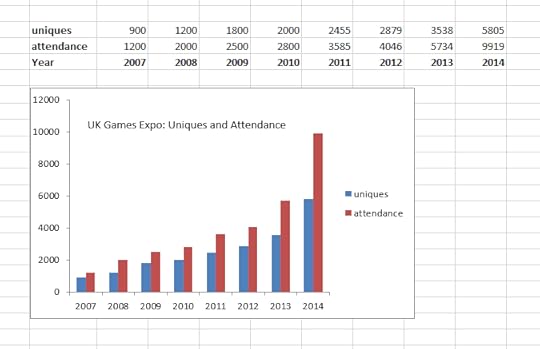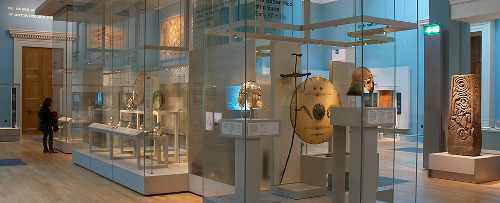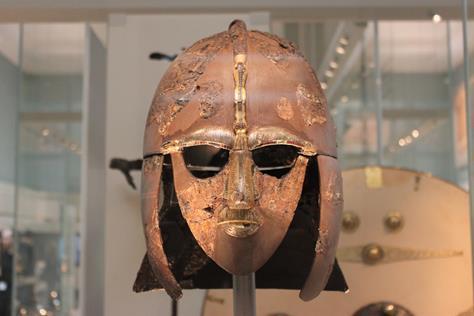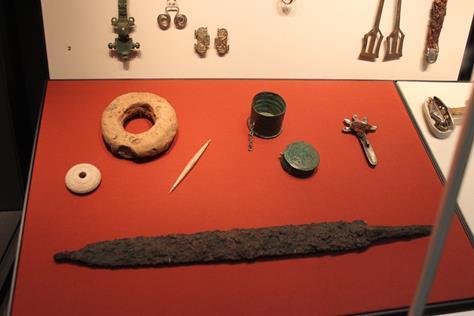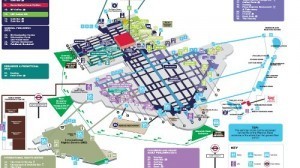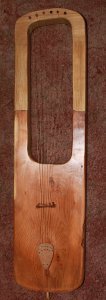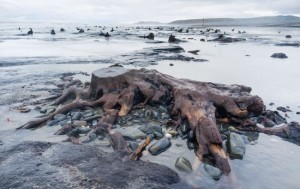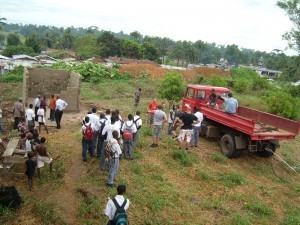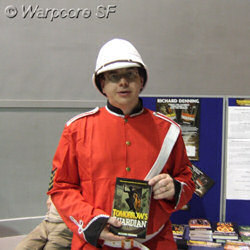Richard Denning's Blog, page 4
June 6, 2014
Its a Monster! The past and future of UKGE
UKGE this year has been widely hailed as a massive success. The catering collapsed, Bring and buy could not cope but 99% of attendees and traders recognize these issues were created by the sheer and unpredictable growth of UKGE.
This then my friends is the challenge and opportunity that UKGE presents. The year before the first expo a few of us (of which Pat and I are the remnants) helped run a 200 attendee event which, unless you played D and D Minis, Fow or Warmachines would have passed you by. It was the root of the first expo however and led to UKGE 2007.
That first year we had maybe 1000 individuals and attendance of maybe 1200. Through the first 6 years growth was 20% or so a year.
Last year uniques went up by 25% and attendance jumped by 50% and this year the jump is more like 60% to 70%.
This is exiting dizzy stuff and the possibility of an event of true international standing with over 10000 attending is not the pipe dream it was in 2007. BUT there are issues. The Hilton can only hold a certain number. Even with a properly constructed and heated marquee the size of the Kings capacity will outstrip demand very soon.
It is clear that we organizers along with our main partners and sponsors need to do some serious thinking. There are options that many of you have already suggested: bringing in nearby hotels for some events, the new build across the lake, the NEC but the reason why we are thinking hard is we don’t want to loose that buzz, that excitement and vibrancy. Hopefully you will all help us maintain that whatever the final plans are.
We will be at the Hilton next year with “additions” and many modifications and will keep you in the loop just as soon as the loop exists.
April 13, 2014
Anglo-Saxon Hall at The British Musuem
Room 41 of the British Museum has been closed for a long spell whilst it was redecorated and a new permanent display brought in. The now reopened gallery houses what is surely the finest collection of Anglo-Saxon artifacts anywhere as well as the most prestigious items from the famous Sutton Hoo burial of King Redwald of East Anglia. Last week I was at the London Book fair but took the opportunity to visit and take some images.
Pride of place goes to this helmet. It belonged to King Redwald and was buried with him around 626 AD. It is one of only 4 helmets that survive from the Anglo-Saxon period – a reminder that what we know of these people is based often on limited records or finds.
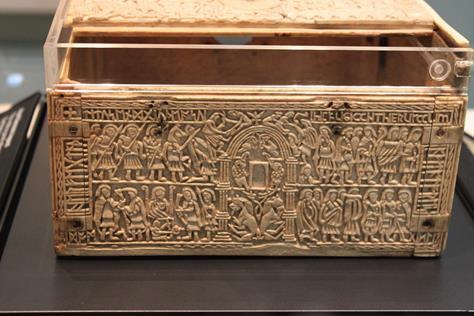 The Franks Casket was made around AD 700 in Northumbria. It contains scenes in which the fairly new Christian Faith and the older Pagan tradition were side by side -as the people tried to maintain the best of both worlds. It also shows many runes and is one of the examples of evidence we can turn to to show what the Early Anglo-Saxons believed and how they wrote.
The Franks Casket was made around AD 700 in Northumbria. It contains scenes in which the fairly new Christian Faith and the older Pagan tradition were side by side -as the people tried to maintain the best of both worlds. It also shows many runes and is one of the examples of evidence we can turn to to show what the Early Anglo-Saxons believed and how they wrote.
Along side these magnificent artifacts are more mundane but sometimes more striking pieces. Examples of grave goods are show.
This cabinet shows typical artifacts found in female graves. Examples include bone or clay weaving equipment like loom weights and whorls and iron batterns. Also shown is a needle box.
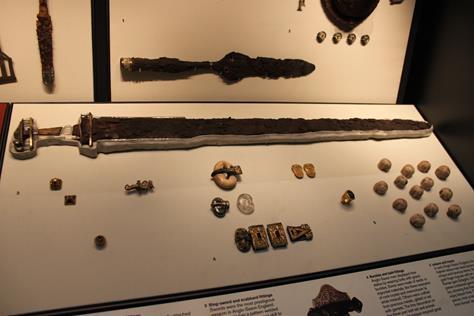 Male graves might contain weapons, buckles from belts, game pieces and sometimes money.
Male graves might contain weapons, buckles from belts, game pieces and sometimes money.
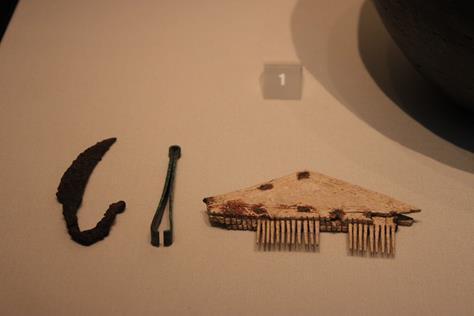 In the graves of men and women we might find items used to keep clean and groomed. Here is a razor, tweezers and bone comb.
In the graves of men and women we might find items used to keep clean and groomed. Here is a razor, tweezers and bone comb.
There are many replica items and reconstructed artifacts and example being this shield:
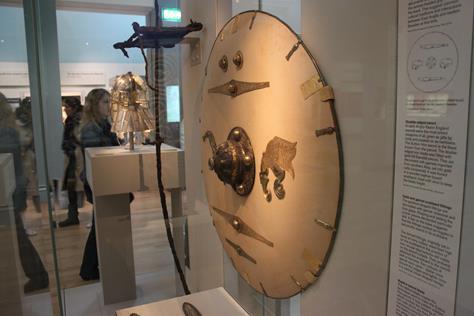 For anyone interested in history this reopened hall is worth a visit but for those of us with a more specific interest in the period there are many items here worthy of study.
For anyone interested in history this reopened hall is worth a visit but for those of us with a more specific interest in the period there are many items here worthy of study.
April 10, 2014
London Book Fair – An Author’s Perspective
I visited the London Book Fair yesterday. This was only my second visit. I went before in 2010. There is no doubt that it is an impressive sight – the Earl’s Court Exhibition Center full of trade stands for publishers, distributors, author services and self publishing companies. Its the Annual gathering of the book industry in the UK. Vital for Publishers and distributors. But is it worth a visit as an author?
The short answer is it depends. It depends on what you are trying to get out of it. If your intention is to turn up with your unpublished manuscript, stride up to Harper Collins and slap it on the table and say how much for this then? Well, you would be disappointed. What LBF is not is an opportunity for authors to pitch to agents or publishers. The agents and publishers have full diaries meeting each other and distributors and agreeing deals, assigning rights etc. The right way to approach the book fair is as an information gathering exercise and really at least as much from the publishing side of being a self published author as the author bit. In other words if you are looking for a company to assist you with publishing, proof reading etc then there were many such companies present. Likewise if you needed help with e-book conversion and sales, audio books and animated books for Ipads etc then there were plenty of people to talk to.
When I visited in 2010 I attended talks heralding the coming of Kindle to the UK and the use tablets like Ipads for books. In the 4 years since then a revolution in publishing has come – or rather 2 revolutions. E-books are taking a large and increasing share of the market but also the world has seen the creation of a good umber of Self Published Millionaires and many if not millionaires quite successful authors who made their fame or fortune via Kindle, Kobo etc. What was interesting yesterday was that I attended a couple of talks by these authors – something that would not have occurred in 2010 and this shows the growth of the Indie sector.
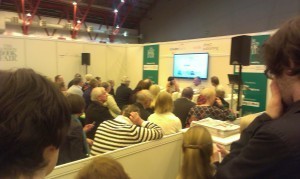 So what did I do at the fair? Well when I arrived I first had a meeting with Helen Hart of Silverwood publishing. I am self published and wanted Mercia Books to continue but was looking at hiring in a few services like typesetting to improved the look of the books. LBF is ideal for that type of talk. It was nice to catch up with Helen as I had last seen her at the Historical Novel Conference in 2012. I then strolled around the stalls and found someone I knew from UK Games Expo – Racheal Wyatt of Coiledspring selling games related to books and words.
So what did I do at the fair? Well when I arrived I first had a meeting with Helen Hart of Silverwood publishing. I am self published and wanted Mercia Books to continue but was looking at hiring in a few services like typesetting to improved the look of the books. LBF is ideal for that type of talk. It was nice to catch up with Helen as I had last seen her at the Historical Novel Conference in 2012. I then strolled around the stalls and found someone I knew from UK Games Expo – Racheal Wyatt of Coiledspring selling games related to books and words.
I had lined up a few Seminars to attend and the first one then began. There are a number of streams of seminars around LBF. Some are very technical, some focused on Publishers and larger companies and of no value to authors. They do however have an Author HQ where a series of talks of use for authors took place. Another nearby Tech Theatre was home to short 20 minute presentations by a series of companies on e-book services and distribution.
The two major seminars I took in were:
Independent Bestselling Authors Discuss Using Kindle Direct Publishing And CreateSpace To Fuel Readership Growth. UK Kindle Direct Publishing Manager, Darren Hardy hosted this and interviewed Indie authors Tim Ellis and Mel Sherrat both of whom write full time and have successful Indie careers.
Then later (after the two techie talks) I went to Eating The Cake, Too: The New Breed Of “Hybrid” Authors Have The Best Of Both Worlds.
This time it was Diego Marano, Manager, UK, Kobo Writing Life interviewing Hugh Howey, Author – a extremely successful Indie Author.
What was clear from their conversations was that, to the disappointment I felt of some of the crowd, that there is no magic, quick route to success. Nor was there a single template or agreement on the best approach.
The bottom line seemed to be keep writing. Finish one book and get the next one started. Ensure the books are well edited and presented. Outside of that there was a wide approach to other aspects of writing. So one author was adamantly opposed to free books, whilst another swore by giving away free books as a route to getting a following. One might focus on marketing and another hardly do anything. The only thing they did agree on is getting a number of titles out there and ensuring they were well produced.
Afterwards, speaking to Kobo and Barnes and Noble I discovered I had missed the fact that they were both accepting direct submissions from Authors in the UK (not just via Smashwords). They were able to give me information about this.
SO is it worth a visit as an author? Yes if you go along with the aim of learning about self publishing and sourcing services or else plan to listen and learn from the other authors. Just don’t expect to get a five book deal by bumping into the CEO of a Big Six company.
April 1, 2014
Thoughts on The 2nd Self Publishing Conference
This Sunday was bright and sunny. I was tired after helping my daughter do a charity event on the Saturday evening and of course the pesky clocks went forward. Any sensible mortal would plan a lie in to counter the loss of an hour followed by a walk in the park perhaps. Not I. Along with something like 150 other writers or aspiring writers I got up early and traveled to a leafy suburb of Leicester to attend the 2nd Self-Publishing conference run by Troubadour Publishing.
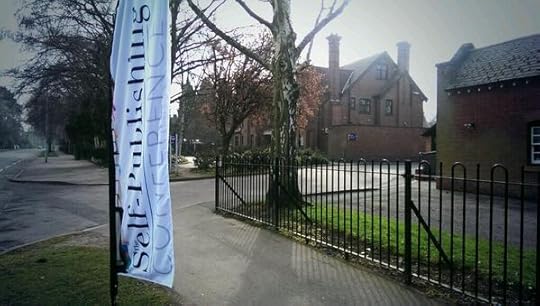
I had heard of this event via a friend Helen Hollick, who in many ways is my mentor having giving me the kick start I needed 4 years ago to adopt a professional approach to self-publishing. By the way I can massively recommend her book on editing fiction called Discovering the Diamond – co written with Jo Field.
This was not an expensive day. Registration fee was £55.00 per person. This includes a delegate’s pack, morning coffee, buffet lunch, afternoon tea and a choice from many sessions on different aspects of self-publishing.
The structure of the day was an introduction by the CEO of Troubador and a key note speech by Alysoun Owen the editor of the Writers and Artists year book which was a good over view of the current state of publishing and self publishing. She showed us the growth of self publishing in the last few years and how it both has become a viable approach for many authors but also a massively competitive area due the simple vast numbers of authors and aspiring authors out there.
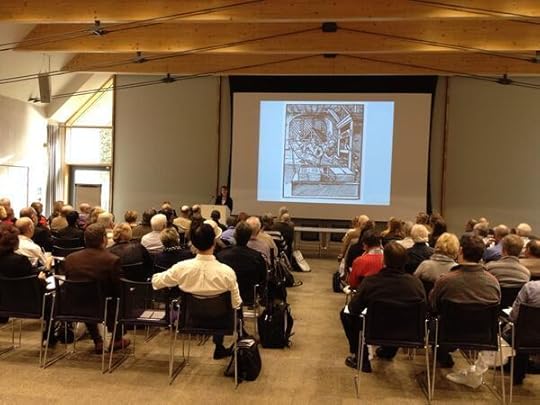
The rest of the day was split into 4 sessions of 75 to 90 minutes each divided by coffee breaks and lunch. Accross these 4 sessions there were 21 different sessions to choose from and I found that I often had a tough decision between more than one speaker. The sessions I chose were:
Working Successfully with bookshops and libraries to sell your books.
The speakers took us through approaching local libraries individually, developing a relationship perhaps by offering events and free books, to going through the central buying departments. With budgets shrinking the message was that is is not easy to get adopted in every library and you are more likely to succeed with local studies and history/ interest books than fiction. As for getting into bookshops we were encouraged to ensure books were of course well presented and professional, on distribution via Gardners etc but even then there would be a low chance of getting onto the shelves of Waterstones and Smith.
One useful snippet from this talk is to keep an ear to the ground on any upcoming festival or literary event in libraries etc as you might just have a book or books that could fit. Then contact community librarians and offer up talks etc.
From Self-publishing to mainstream and back again
Polly Courtney was an investment banker who after working in the city left to write books on her experiences. Her first novel Golden Handcuffs failed to gain much interest until the 2008 financial crash when she self published, managed to get coverage linked to the crash and basically that kicked off her sales. She was picked up by Harper Collins and had a frustrating time finding that they would design covers that did not suit her books or even give the books titles that were wrong. She eventually came back to self publishing and has a successful career writing as well as doing talks. An interesting message I took from her talk was the need to be very proactive with marketing books and to be open to the right opportunity that the world flings at you.
Whilst Waiting for Helen Hollick to go to lunch I chatted to Jane Rowland former editor of the Self Publishing magazine and she reminded me that the magazine does take review books from self published authors. Over Lunch Helen and I discussed having books in print in the USA and UK and the possible needs for different covers and editions.
Promoting your Book to Online Bookshops
This session by Steve Potter of Wordery covered how to get your books on sale on Amazon, Wordery and elsewhere but also marketing using Twitter, Pinterest etc. the sheer vastness of social media means that one needs a focused strategy so as not to loose all day online. Checked on my ipad and my books are on sale on Wordery too so that was one job I dont need to do.
Successful Promotion for Children’s Authors
Basic take home message: for all children under 8 you are trying to reach the parent not the child. For 8 to 12′s its a mix of getting the message across to child and parent and for teens it is the reader themselves. Reviews are critical and here there are many blogs and sites who will do reviews. The talk covered doing school visits etc.
As I say there were many other sessions on for example ebook publishing, book covers, book reviews and the importance of employing a good editor etc.
Overall I found that I was doing most things I should be doing but I did pick up a snippet or two from each talk to take further. The conference allowed for a lot of networking and I did think that what would REALLY help would be a full list of delegates, who they were and what they were as well as speakers along with contact info for everyone as I think many of us wanted to follow up chats we had during the day. So my feedback would be to have a contact list.
Otherwise I can not think of very much wrong with the event and can recommend it to aspiring writers and indie/ self publishers.
March 15, 2014
What did the Anglo-Saxons do for fun?
the year is AD 600. There are no Ipods, no Internet, no TV, radio and not even newspapers and books (unless you were wealthy ). What do you do to keep from getting bored?
Here are some ways that the Anglo Saxons had fun in the dark evenings.
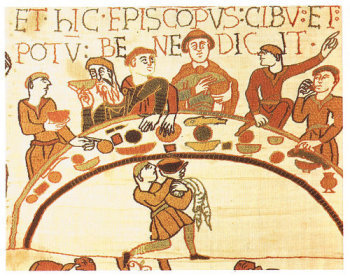
Indoor entertainment and feasts
There was a high degree of ceremony connected with feasts. It would start outside the hall. A horn was blown to summon the guests to table and the host would great them at the door where there would be a hand washing ceremony at the door. The doors were shut to keep gate crashers away!
Then the guests would enter and sit at benches lining long tables. The king’s warriors or thegns could sit in his halls but only men of high rank would sit at the high table. Women of high rank would be cup bearers and pour drinks for the king and lords. In the Christian era bread was blessed and then broken in remembrance of the Eucharist or holy communion/ mass.
Feasts might go on all day and night: there were even some 3 day feasts.
It was considered a serious matter to commit an offense or undertake violence at a feast
Entertainment at feasts: These might include playing the harp, lyre, horn, trumpet, drums flute or cymbals. There would be accompanying signing: often songs recalling battles.
They enjoyed dancing and juggling and the asking of riddles. Here is a typical Anglo-Saxon riddle from the Exeter book which has many riddles. Some are obscure and some lewd and suggestive. This one is straighter forward.
On the wave a miracle: water turned to bone.
What is the answer? See at the end of this section.
The Saxons loved stories such as has every generation of humans from the earliest times. In the long lost mead halls of the Saxons tales of the past, of monsters and kings and heroes were told. In one of these halls the tale of Beowulf would have had its world Premier as we think of such things today. Imagine the scene: the fire is crackling and dancing away throwing shadows against the walls. The bard stands in the firelight. The rumble of conversation from the benches dies away. The poet bows to the king who inclines his head, signalling that the tale should begin. The unknown genius begins his tale – a story that to the Anglo-Saxon settler echoed back to earlier times and linked him to his past on the shores of distant Denmark just as that same story remains with us a powerful link to our own past in these Saxon halls.
Lo! the Spear-Danes’ glory through splendid achievements
The folk-kings’ former fame we have heard of,
How princes displayed then their prowess-in-battle.
Though today the language is archaic is difficult to grasp at times there is no doubting the power of the words. Or (from a writers point of view just how many references are made to traditions of this warrior culture – references that help to reinforce our knowledge – such as Beowulf’s funeral :
THEN fashioned for him the folk of Geats
firm on the earth a funeral-pile,
and hung it with helmets and harness of war
and breastplates bright, as the boon he asked;
and they laid amid it the mighty chieftain,
heroes mourning their master dear.
Then on the hill that hugest of balefires
the warriors wakened. Wood-smoke rose
black over blaze, and blent was the roar
of flame with weeping (the wind was still),
till the fire had broken the frame of bones,
hot at the heart. In heavy mood
their misery moaned they, their master’s death.
Wailing her woe, the widow old,
her hair upbound, for Beowulf’s death
sung in her sorrow, and said full oft
she dreaded the doleful days to come,
deaths enow, and doom of battle,
and shame. — The smoke by the sky was devoured.
Games:
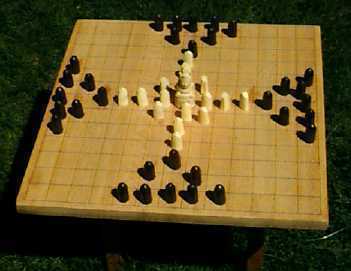
Above: a game of Hnefatafl
The Anglo-Saxons were fond of dice games. Dice were made from the knuckle bones of animals such as pigs. Board games were also popular and often recalled battles in a symbolic way. An example is Hnefatafl which is played using stone pieces on a carved wooden board. One player’s pawns coming from the corners of the board would attack the other side’s king and pawns which were positioned in the centre. The player with the King would be trying to get him off the board (to escape from the battle) whilst the other player would try and trap him. These un-even games – where the two sides were of different sizes and abilities – were very prevalent in Anglo-Saxon and later Viking cultures. The Romans seemed to have brought Nine Men’s Morris and Three Men’s Morris to Britain. The English were certainly playing this my medieval times and it seemed likely that may have been aware of it in the Saxon Period.

Nine men’s Morris
Outdoor Sports:
Horse racing was mentioned in Beowulf in 8th century copy which exists and by the writer Bede in the 7th. There are records of dog racing, hunting, ice skating, swimming, falconry, hawking, acrobatics wrestling and gymnastics.
So we see that the Saxons certainly filled the long dark winter evenings.
Here is the Answer to that riddle:
February 21, 2014
Winter Storms reveal 5000 Year old Forest
Look at these images. You are looking at something that has not been seen for 5000 years. These are the remains of a forest that once flourished in the Cardigan Bay area of Wales in ancient times. You would think by looking at them that these were trees felled by a lumber jack just yesterday but this forest was last above the waves before Stonehenge was built on Salisbury Plain, before the Great Pyramid rose over Egypt, before the first brick was laid in the Great Wall. Indeed these tree trunks have laid covered by sand and silt throughout most of recorded history.
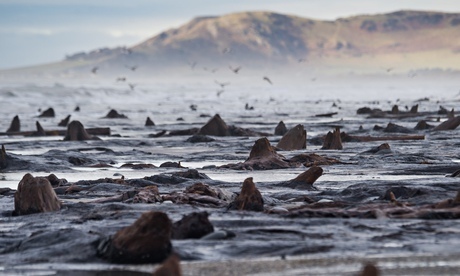
These tree stumps became visible during the dramatic winter storms which have lashed Britain for the last few weeks blasting away the sand and silt. At low tide they can be seen on the beach near the village of Borth, Ceredigion, Mid Wales. Previous times of exposure of parts of the forest may have given rise to the legend of Cantre’r Gwaelod: a,n Atlantis like lost Kingdom beneath the waves.
The Lost Kingdom of Cantre’r Gwaelod
It is thought that low lands off the west coast of Wales were submerged when sea level rose after the last ice age. These lost lands of West Wales are handed down in folklore as the story of the Lowland Hundred or Cantre’r Gwaelod. There are several versions of the myth. The earliest mention of Cantre’r Gwaelod is thought to be in the thirteenth-century Black Book of Camarthen in a poem called “Boddi Maes Gwyddno” (“The Drowning of the Land of Gwyddno”). The tale tells of a country defended from the sea by a wall or dyke. When the floodgates are negligently left open one night, Cantre’r Gwaelod is flooded and lost beneath the waves.
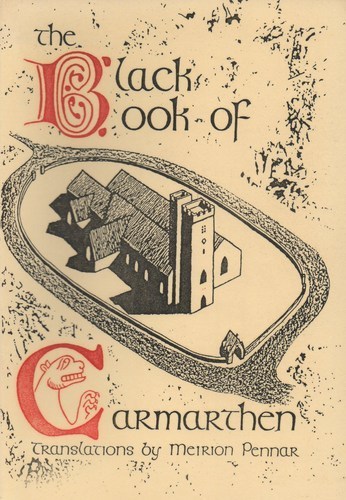
‘When waves crashed on the sea-shore
with thunder in its wake
The bells of Cantre’r Gwaelod
are silent ‘neath the wave’
Whether we are looking at all that remains of a lost Stone or Bronze Age Kingdom or a once vibrant forest there is something haunting and at the same time exciting and enthralling about these images : a snapshot back through two hundred generations to a lost past.

January 30, 2014
Sponsored 24 Hour Charity Gaming Marathon
Playing games for Charity.
This weekend I am running a sponsored 24 hour gaming marathon. This is in aid of Project 3580. This is a charity which members of my daughter (Helen)’s school are supporting this year. You may be aware that the country of Sierra Leone was affected by a terrible civil war and that there are still many displaced people still living in poor circumstances. Malaria is rampant and thousands die annually. Project 3580 is working to improve the lives of members of the community of the Kissi Town Refugee camp on the outskirts of Waterloo in Sierra Leone.
4 members of the 6th form of Lichfield Cathedral School are in fact flying out to Sierra Leone this Easter. These include my daughter Helen who is 17 now. They will spend 2 weeks helping to build facilities there. In advance they are raising funds to give to the charity. Now just to make it clear that this fund raising is not to pay for the students costs. The students have themselves separately funded that – in Helen’s case by a kind donation by my parents and grandmother. So this current fundraising is purely for Project 3850.
When Helen told me that she was raising funds for the charity I thought about what I could do to help. What skills and talents and knowledge do I have? Well I have been a junior doctor who has in the past stayed awake for 48 hours and more and I know games and run gaming groups and even the odd convention (when I am also awake for long stints). So I said – why don’t I run you a 24 hour gaming Marathon. Let get together a dozen or so folk and we will commit to playing board games, card games, quizes etc for 4 hours. We make it fun – with some prizes I will provide. Jane and I will provide the food and drinks (lots of Red Bull) but you and your pals get sponsorship. All proceeds go to Project 3850.

boot load of games on standby
So this Saturday 1st February at Noon at Lichfield Cathedral School we are holding this 24 hour gaming Marathon. The 10 young kids (all around 17 and 18) are all about to be introduced to some of the best board games (Settlers of Catan, Ticket to Ride, Bohnanza, Munchkin, Formula De, 7 Wonders, Dominion, Cash and Guns and more), some fun quiz games and a few rounds of Werewolf, Apples to Apples and other party games. The rules are they all have to be sponsored, they all have to stay awake for the 24 hours and that games must be being played continually (allowing for brief down times for pizza, bacon rolls and toilet runs). Jane and I will be running this with some supervision from teachers. I will post on facebook or here some updates over the 24 hours. We will also be running a grand tournament with scores from each game going towards the total. I will provide some prizes for that.
Should you wish to sponsor the Children and donate to Project 3580 use the button below.
All moneys taken via this paypal link will go to Project 3850. The link uses my own Mercia Books paypal account but all proceedings will be logged and passed on.
We will publish details of what the marathon raised after the weekend.
Find out more about Project 3580.

January 28, 2014
Dungeons and Dragons is 40 Years old!
Last weekend – Sunday 26th January was the 40th anniversary of the launch of a game that would change the world. On 26th January 1974 Gary Gygax launched the original set of rules for Dungeons and Dragons. It was not the first roleplaying game but it was going to have the greatest impact on the hobby. A few years earlier in 1971 Gygax had published Chainmail. This was a set of skirmish rules for tabletop wargaming. They evolved out of medieval wargame rules but took the critical step of introducing fantasy elements to the combat.
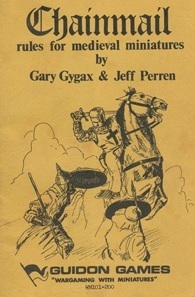
A friend of Gygax called Dave Arneson saw that the mechanics for combat in the chainmail rules could be added to. You could infact create a whole fantasy world along the lines of Tolkien’s Middle Earth, populate it with monsters and treasure and suddenly you had a place ripe for adventures. Arneson created this world and called it Blackmorr. What was needed now was a set of rules that did not just include combat and fighting but allowed the players to interact with the world – to travel around it, to buy stuff and to set out on adventures.
That is what the original Dungeons and Dragons rules were designed for. You actually also needed a copy of chainmail to play the original version but very soon reprints and new versions were on the way.
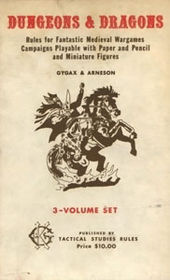
From these humble beginnings a world wide game of massive proportions has evolved. Dungeons and Dragons has gone through several editions.
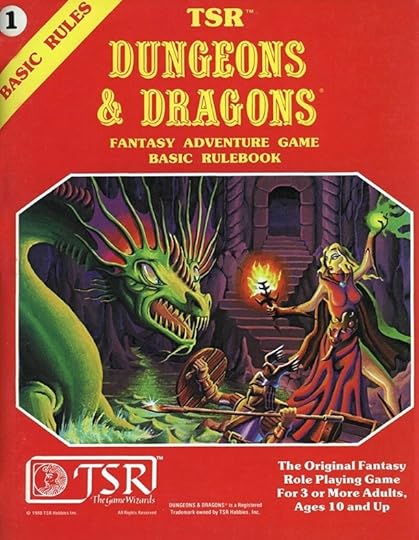
Each developed the game, added more depth and at times disputes over which version was better. Currently the gaming community is split between the “Official 4th Edition Dungeons and Dragons”
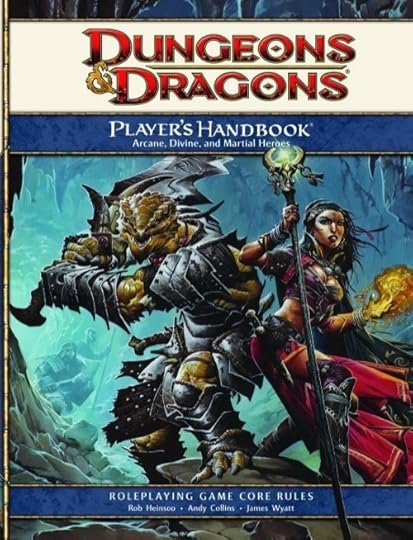
And Pathfinder which is a massively updated revision of 3rd Edition:
[image error]
For outsiders who have never played a game it can seem baffling with it weird shaped dice and its sets of rules that can rival a small library at times:
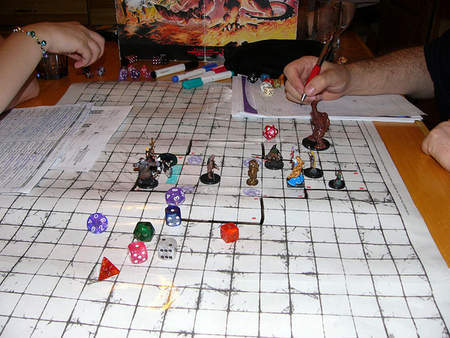
Yet at its heart Dungeons and Dragons like all the other roleplaying games that have developed since (Traveller -Science fiction, Call of Cthuhu -horror, Dr Who -time travel and others) is a big exercise in make believe and story telling. I think that is why as an author I enjoy it so much. Or why I became an author maybe. One of the players is the gamesmaster, Dungeon Master, GM, Umpire or whatever. He creates the world, describes it and populates it with characters. The players are like readers but much better than that. They don’t just read of the adventures – they go on the adventures. they create their own characters full of flaws and strengths and interests and motivation. They interact with the other players and the GM’s world and together the adventure is taken forward.
Its like a book where the author is only in charge of part of it. The players fill in the rest. Roleplaying is just damn good fun and usually laugh out loud fun at times.
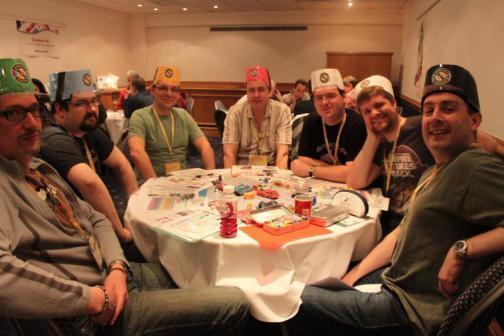
Roleplaying Captain Scarlet at UK Games Expo
D&D has had bad press at times. The bible belt in the US got panicky that it would lead to people worshipping Satan. But they said the same thing about Harry Potter. Its just make believe guys. My fire ball spell really doesn’t work alas.
I tried it on a patient and he didn’t go boom!!
If you want to know more about what all the fuss its about all this gaming – come to best Games Convention in the UK UK Games Expo.

January 26, 2014
Blog Chain: What Am I Working On?
Today I’m pleased to be taking part in a blog chain.
A blog chain is simply a blog post written on a set topic, at the end of which you nominate a given number of bloggers to do the same. So we have a linked set of blogs popping up at intervals covering the same topic. The blog chain is bit different from the blog hop,during which a number of bloggers post simultaneously on the same topic, including links to each other’s posts. I took part in a blog hop just before Christmas: Helen Hollick’s excellent Winter Solstice Blog Hop. In this blog chain we are looking at the topic “What am I working on?”
Receiving the baton:
Passing the Baton to me is the author Helen Hollick. Helen is the author who really got me started self publishing. She took me under her wing, encouraged me and introduced me to her editor (now also mine) and book cover artist (ditto). Helen is a writer of Historical Fiction and Fantasy. Her main periods are the Arthurian era, Anglo-Saxon England and also the age of piracy. You can read her answers here:
http://ofhistoryandkings.blogspot.co.uk/
So then on to my questions and answers:
1) What am I working on?
Right now I have just published The Catacombs of Vanaheim which is a children’s Historical Fantasy and the sequel to the first in the series, Shield Maiden. This series imagines a world where the Germanic-Norse mythology is real and we follow the adventures of a young Anglo-Saxon girl in Mercia with the back drop of that mythology. I have turned to writing the third in my time travel adventure story for young adults called “Today’s Sacrifice”. That like the first two in the series is a fast moving gallop through history. I actually have 4 series on the go and tend to rotate them. Thus whenever I return to a series its fresh and exciting to be back there. After Today’s Sacrifice I may do he 4th in the Historical Fiction series “Northern Crown” which is about early Anglo-Saxon England. That series take a lot of research and I always have a book about the period open around the house.
2) How does my work differ from others of its genre?
As I said I have 4 series on the go. The Nine Worlds Series with its mix of Germanic mythology and Anglo-Saxon history is – I think – fairly unique. Least ways I have not come across any children’s books in the same genre. There are Time travel adventure stories a plenty and I don’t pretend that the Hourglass Institute Series is particularly unique. It is meant to be exciting, fast paced and just plain fun. I do spend a lot of time on the historical research. Right now I am writing a scene where the team appear at the Battle of Waterloo which allows me to use knowledge of the period. The Northern Crown Historical Fiction series has the virtue of being set in a period which has very few other authors working in – the early but post Arthurian Saxon era. I am told I write very good battle scenes and I do love those. That period allows the reader to experience the dramatic historical events that helped forge Britain. Finally my 4th series has one book so far – The Last Seal. Again here I am blending fantasy with history in a tale of demons and magic and the Greta Fire of London. I think sometimes mixing genres can give a fresh take on a story.
3) Why do I write what I do?
I write the sorts of books I want to read. If I got lots of poor reviews I would probably stop publishing them but the reviews are generally good and I do get encouraging emails and comments from readers so I am encouraged to press on. I also love the worlds and characters I have created. I want to know what happens next and so have t carry on writing to find out. So yes its fairly self indulgent but why not!
4) How does my writing process work?
I have a combination of day job, writing carer and a job running an annual convention of board games that gets 4000+ attendees each May/June. The late winter and spring is increasing devoted to thousand of emails and hundreds of hours planning and organising a convention which sees 4000 people attend over 3 days along with 100 exhibitors to play hundreds of board games and roleplaying games (all a passion of mine). There are seminars to organize, guests to invite, hotel rooms to books etc. As a result for a third of the year the writing goes on hold. However I still do some visits to schools and try and keep busy on the social media. etc After Expo is over and tidied away I get about 4 months where I can focus exclusively on the writing so I try and get a draft of a book ready in that time. Then towards the end of the year and over the winter I have to mix some work on Expo with writing something. If possible I try and get the latest book finished so it can be edited and prepared and released. Some years I manage 2 books, some just 1 new release.
When it comes to the actual writing process I spend I while thinking about the characters and plot. I try to then write a bief outline, then add details to the outline, fleshing it out in stages so that when I start writing I already know most of what is going to occur. I aim to get a first draft done quickly and messily. Only I read it and I then redraft it before allowing my wife or parents to read it and give me feedback. It then goes through a couple of drafts again (at least) before going to my editor.
Passing on the baton:
So I now pass the baton on to another writer. I look forward to hearing her answers.
 Marilyn L Rice took early retirement from teaching and began her writing career. On her 50th birthday she launched her first book Time & Tide in a West Bromwich Shopping Mall. No Regrets followed in May 2003. Then, Stay in Touch in 2005 and in 2007 her fourth work, Look After Each Other. This was taken on by Strategic Book Publishing (an American Publishing Company) who released the sequel to Look After Each Other… Sofia’s Legacy. Love You Forever, (coming soon!) is the final work in the ‘Sofia’ trilogy and her legacy!
Marilyn L Rice took early retirement from teaching and began her writing career. On her 50th birthday she launched her first book Time & Tide in a West Bromwich Shopping Mall. No Regrets followed in May 2003. Then, Stay in Touch in 2005 and in 2007 her fourth work, Look After Each Other. This was taken on by Strategic Book Publishing (an American Publishing Company) who released the sequel to Look After Each Other… Sofia’s Legacy. Love You Forever, (coming soon!) is the final work in the ‘Sofia’ trilogy and her legacy!
Marilyn’s answers will go up on Monday 3rd February.
http://lookaftereachother.blogspot.com
January 16, 2014
Men of Harlech
In the struggles that defined the British Isles the clashes between the English and the Scots, Welsh and Irish have all been remembered in song. Speed, bonnie boat, like a bird on the wing, Onward! the sailors cry; Carry the lad that’s born to be King Over the sea to Skye with its haunting mornful melody recalls the defeat of Bonnie Prince Charlie in the 1745 Jacobite uprising. “Erin Go Bragh” and dozens of other songs recall the struggles between Ireland and England. But to me one of the most powerful songs is Men of Harlech.
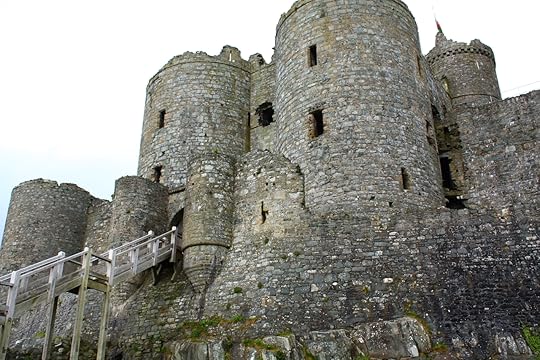
Men of Harlech is a is a song which describes events during the siege of Harlech Catle in Northwest Wales between 1461 and 1468. The siege was longest recorded siege in the history of Britain. Commanded by Constable Dafydd ap Ieuan, the garrison held out for seven years. It is no surprise then that the song is sometime called “Through Seven Years” .
“Men of Harlech” is a very significant patriotic song in Wales and became internationally known when it featured in a slightly unbelievable but still very stiring way in the 1964 film Zulu. Ironically the siege that were the origins of the song however was part not of a struggle between Welsh and English particularly but in fact all part of the Wars of the Roses. Queen Margaret fled to the castle after defeat at the Battle Northhampton and it was in fact her Lancastrian supporters, under the command of Dafydd ap Ieuan, who held the castle for seven long years against the forces of Yorkist Edward IV.
Harlch Castle (actually one of the string of castles built by Edward I) had very heavy defences and also had a supply route by sea and so was able to hold out so long. Indeed the Lancastrians were able to mount raids and even become a base for fresh troops from France. Eventually Edward IV sent an army possibly up to 10,000 strong, to finally seize the castle. Eventually famine forced surrender and Dafydd handed the castle to Lord Herbert a the Yorkist commander on honourable terms. King Edward IV at first refused to honour the terms of the settlement but Sir Richard Herbert, out of respect for the bravery of the defenders, is said to have offered his own life rather than see his promise broken.
It is these defenders then that were the Men of Harlech commemorated in the song. It seems odd in a way then that the song is full of praise of Welsh bravery and tenacity against the English attacker. Why? Possibly the actual garrison was made up heavily and mainly of Welshmen and something of the rivalry between the races was used to stir up resistance. Maybe the defenders were reminded of an earlier siege where forces loyal to Owain Glyndŵr, the great leader of Welsh resistance to English rule, held the castle during a siege. That siege however only lasted a year not the seven that the song was named after. Certainly the songwriter was Welsh. To this unknown Welsh songwriter the bitter struggle that was always there in the background was against the English. Indeed the fight between the Welsh and The Anglo-Saxon tribes was so rooted in the history of a thousand years that the early versions of the song talk about the Saxon Foe. It first appeared with Welsh lyrics in Gems of Welsh Melody, edited by the Welsh poet, John Owen (Owain Alaw), published in 1860. As such the English words don’t fit the melody well. Here are some of the words in English:
March ye men of Harlech go, Lov’d fatherland your duty claims,
Onward comes the Saxon foe, His footsteps mark’d in flames;
But his march breeds no dismay, Boasting taunts we meet with scorn,
Craven like their hosts shall flee Like mists before the morn.
On the foemen dashing, Swords and bucklers clashing;
Smite with will their savage band Nor think of e’er retreating:
But with a firm unflinching hand, In blood quench ev’ry burning brand,
And for each roof tree cast away A Saxon life shall pay.
Now we are not certain about what tune the original song used. Tradition states that the modern tune is in fact the folk tune that was used but we cant be certain. Over the centuries the words have changed and many different verses have been written. This version comes from 1873. Here the words certainly fit the modern tune:
Men of Harlech, march to glory, Victory is hov’ring o’er ye,
Bright eyed freedom stands before ye, Hear ye not her call?
At your sloth she seems to wonder, Rend the sluggish bonds asunder,
Let the war cry’s deaf’ning thunder, Ev’ry foe appal.
Echoes loudly waking, Hill and valley shaking;
‘Till the sound spreads wide around, The Saxon’s courage breaking;
Your foes on ev’ry side assailing, Forward press with heart unfailing,
Till invaders learn with quailing, Cambria ne’er can yield.
Thou who noble Cambria wrongest, Know that freedom’s cause is strongest
Freedom’s courage lasts the longest, Ending but with death!
Freedom countless hosts can scatter, Freedom stoutest mail can shatter,
Freedom thickest walls can batter, Fate is in her breath.
See they now are flying! Dead are heaped with dying!
Over might has triumphed right, Our land to foes denying;
Upon their soil we never sought them, Love of conquest hither brought them,
But this lesson we have taught them, Cambria ne’er can yield.
There are still mentions of the Saxon enemy. Cambria used here to mean Wales. (Wales and Welsh were the Saxon names not the native name for them selves). Note also the comments about not yielding. This is very suitable given the Welsh held out for seven long years under siege. Both the word Cambria and the concept of not yielding went forward into the special version of the song written for the 1964 movie Zulu.
Zulu
A special version of the lyrics was commissioned for the movie starting Michael Caine. The feeling was all that stuff about the Saxon foe would be a it confusing when the enemy – in the film – were now the Zulus not the English. The movie is set during the siege of Rorke’s Drift where 120 British soldiers held out against 4000 Zulus. In a single night more Victoria Crosses were won than in any other battle involving British forces As the brave Zulus advanced in the face of British Volley fire, singing their own song, the Welsh break into song them selves. This almost certainly did not occur or if there was some singing it was not as dramatic as portrayed. But what the hell – its a good movie.
Men of Harlech stop your dreaming
Can’t you see their spear points gleaming
See their warrior pennants streaming
To this battlefield
Men of Harlech stand ye steady
It cannot be ever said ye
For the battle were not ready
Welshmen never yield
From the hills rebounding
Let this song be sounding
Summon all at Cambria’s call
The mighty force surrounding
Men of Harlech on to glory
This will ever be your story
Keep these burning words before ye
Welshmen will not yield
Hope you enjoyed this look back at the evo
lution of this song. Now where is my pith helmet. Oh yes:

